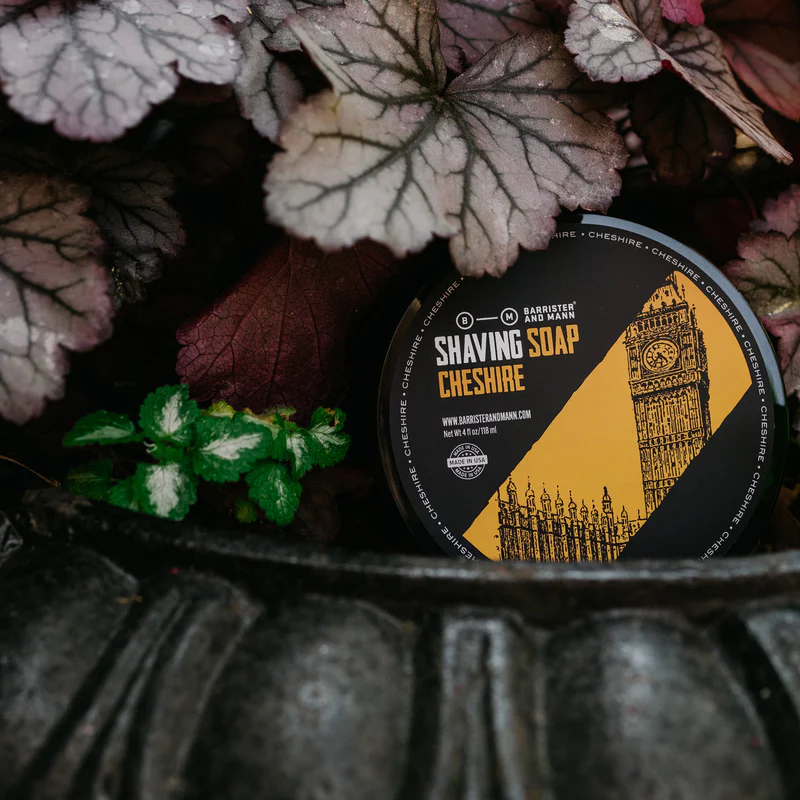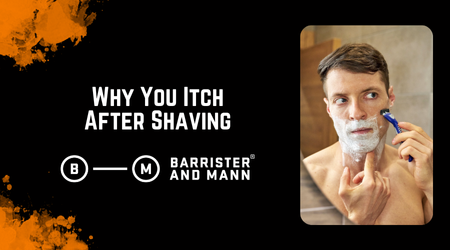Shaving soap is a traditional grooming product, made with fats and oils, that lathers with a brush to create a dense, protective cushion between your skin and the blade. It differs from regular soap by focusing on glide, moisture, and skin barrier protection.
-
Shaving soap is not a regular bar of soap: It’s designed to provide slickness, cushion, and stability during shaving. Regular soap cleans. Shaving soap protects.
-
Shaving soap comes in several forms: Hard pucks, soft tubs, and sticks for travel. Each format influences how you build and apply the lather.
-
It is made with specific ingredients for performance: Ingredients like saponified stearic acid and tallow form the soap base, while things like glycerin, shea butter, coconut milk, and cupuaçu butter are added to boost lather density, skin feel, and hydration without compromising glide.
-
Shaving soap outperforms cream in key areas: It lasts longer, contains fewer irritants, provides more control over lather density, and often includes fewer irritating additives. Cream is easy. Soap is better.
Let’s take a closer look at what makes shaving soap worth the switch.
What Is Shaving Soap?

Shaving soap is a specialized grooming product crafted to do one thing exceptionally well. It creates a thick, slick, stable lather that protects the skin and improves the performance of your razor. You load it with a damp brush, build it in a bowl or directly on the face, and apply it like paint.
When done right, the result is a cushion of dense lather that offers far more control and glide than anything from a can.
This isn’t a new idea. The earliest recorded use of shaving soap goes back to barbers in the 14th century. It was standard for centuries until pressurized foam and mass production came along. But traditional shaving soap never really disappeared. Instead, it has become a niche tool for people who care more about the result than the marketing.
Unlike a standard bar of bath soap, shaving soap is designed for a different purpose. It is designed to stay wet longer, cling to the skin, and support the razor rather than strip the skin. The difference is chemical, not just cosmetic. If you’ve ever shaved with a regular bar of soap and walked away feeling scraped raw, you’ll understand why they’re not interchangeable.
The Difference Between Shaving Soap and Regular Soap
-
Lather structure and intent: Regular soap is made to cleanse. Shaving soap is made to cushion. The two are not interchangeable.
-
Superfat levels are much higher in artisanal shaving soaps: That extra oil makes it gentler and more protective, but less effective at washing away dirt and oil.
-
Can it clean your skin like regular soap?: Technically yes, but you wouldn’t want it to. Shaving soap is optimized for slickness, not scrubbing. It leaves the skin’s natural barrier intact rather than stripping it away. Grime is not its job. Glide is.

What Forms Does Shaving Soap Come In?
Shaving soap comes in more varieties than most people expect. Some are as hard as set candle wax, others are soft enough to scoop with a finger. Some are meant to live in a ceramic bowl on your bathroom counter. Others are packed into slim tubes for travel. The format you choose affects everything from how you load your brush to how long the soap lasts, and each one offers advantages.
Pucks, Tubs, and Sticks: What’s the Difference?
-
Puck: A traditional, dense disk of soap. Usually sold as a refill to drop into a shaving bowl or mug. It takes a little more time to load, but lasts for months with daily use. This is the most common format for milled soaps, prized for their longevity and clean, dry storage.
-
Tub: A softer soap typically poured directly into a plastic jar. Ideal for bowl lathering or face lathering straight from the container. Easier to load than a puck but usually used up a bit faster. Most artisan soapmakers, including us, fall into this category.
-
Stick: A compact, travel-ready format. Rubbed directly onto damp skin and then lathered with a brush. No need for a bowl and great for on-the-go shaves. Surprisingly effective for its simplicity.
What Is Shaving Soap Made Of?
Every good shaving soap starts with a blend of fats and alkali. That blend is the foundation. Without it, you do not get a stable lather or the slickness needed for a clean, close pass.
-
Core ingredients: Stearic acid and tallow or palm oil are the backbone of the lather. Glycerin locks in moisture.
-
Oils: Coconut milk, avocado oil, kokum butter, and cupuaçu butter add creaminess, glide, and conditioning. These are not just extras. They change the way the soap behaves on the skin.
-
The role of saponification: We use potassium hydroxide and sodium hydroxide to turn oils and butters into soap. The balance of these determines whether the final product is soft or hard. Soft soaps favor potassium. Harder pucks lean more on sodium.
-
Some soaps work better in hard water than others: The mineral content of your tap water can interfere with lathering. Our formulas are tuned to handle a wide range of water conditions without falling apart or going gummy.
Unique Additives That Make a Difference
Some ingredients are purely functional. Others elevate the experience.
-
Moisturizers like saccharide isomerate: This pulls water into the skin and keeps it there. You can feel it hours after you rinse.
-
Fragrance artistry: We blend natural and synthetic materials to build original and skin-friendly scent profiles. Each fragrance is designed in-house, structured with intention, and layered like fine perfume. It is not an afterthought. It is the point.
🚨Note: Avoid Shaving Soaps With sulfates (or other synthetic detergents), parabens, aerosol propellants (such as isobutane, which is both irritating and drying), or micas/pigments/clays that may irritate sensitive skin in some users.
Benefits of Shaving Soap vs Shaving Cream
Shaving cream does one thing well: It lathers quickly. But if you're looking for protection, comfort, and skin that feels good after the shave, shaving soap has it beat. It is slower, yes. But better in every other way.
Lather That Performs Like Greek Yogurt
The first thing you notice is the density. A proper shaving soap lather looks and feels like whipped yogurt. It clings to the face, cushions the blade, and stays put through every pass. That density matters. It keeps the razor from skipping or digging in, especially if your beard is thick or your skin, like mine, reacts to everything.
Then there is the slickness. A well-formulated soap produces a layer so smooth that the razor glides effortlessly. No tugging. No sticking. Just a clean, efficient cut with far less irritation.
Longer Lasting and More Cost-Effective
A puck or tub of shaving soap lasts longer than a tube of cream, with milled soap pucks often stretching up to a year of daily use. Even if you shave every day, most tubs will give you three to six months of consistent performance.
While a puck or tub of soap may cost more up front than a can or tube of cream, you use significantly less each time. The price per shave usually ends up lower, and the performance is in a completely different league.
This also means less packaging to throw away, which the environment will thank you for.
Skin Health First
Most shaving creams rely on sulfates and detergents to create that foamy texture. That might work fine for a body wash. But if you have sensitive skin, they are best avoided. They strip too much, too fast, and leave the skin more vulnerable with every pass.
A quality shaving soap skips all that and instead leans on glycerin, butters, and skin-loving oils.
This makes it a better choice for anyone dealing with rosacea, eczema, or just a face that gets angry when you shave too often.
And if you are worried about fragrance, know this: we keep scent levels well within skin-safe limits. We choose our scents based on what is best for your skin, whether that means an extract or a carefully selected synthetic alternative that performs better and causes less irritation.
The Learning Curve Is Real, and Worth It
Shaving soap does not hand you a perfect lather on day one. You have to work for it. Maybe the first few tries are a little thin or dry. Maybe you wonder what the fuss is about. But then it clicks. And once it does, you never look back.
You have to learn how much water your brush holds. How long to load. How to build the lather in your bowl or on your face. Too much water and it collapses. Too little and it drags. It is a skill, like making good coffee or tying the perfect knot. And once you have it, you will wonder why you ever settled for canned foam.
There is no app for this. No shortcut. But that’s the point.
Mastering shaving soap is part of what makes it satisfying. Every shave gets better. Every detail gets easier. And the moment it all comes together, you realize why so many people treat this like a craft instead of a chore.
Why Wet Shaving Enthusiasts Swear by Shaving Soap
There is a reason people get hooked on wet shaving. It is not just about results, though those are better too. It is about turning something mundane into something you look forward to. Shaving soap is the heart of that experience.
It’s a Ritual, Not a Chore
A good shave takes time. Not a lot, but enough to make you slow down. And when you do, you make fewer mistakes. Fewer nicks. Less irritation. The process forces you to be present, which is rare and welcome in the middle of a rushed morning.
Then there is the scent. You lather up with something warm, rich, and clean-smelling. Suddenly, your bathroom smells not like tile cleaner, but like a real barbershop. That moment alone makes it worth switching.
The Joy of Discovery
The first time you get a perfect lather, it sticks with you. The first time you find a scent that makes you want to shave again the same day, it changes your standards. Shaving soap opens that door.
There are soaps for every mood. Every season. Every skin type. Some days you want clean and bright. Other days, you want rich, dark, and resinous. That variety keeps it interesting. It is why some people never settle on just one and end up building a rotation of scents and bases that match the mood, the weather, or the day ahead.
Ready to Make the Switch?
If you have never used shaving soap before, this is your sign. Maybe you’re dealing with irritation. Maybe your current routine feels rushed or clinical. Maybe you just want to enjoy the process instead of tolerating it. Shaving soap changes all of that.
It gives you control. It gives you comfort. It makes your shave feel like something you chose to do, not something you had to.
Curious? Here are a few of our most loved offerings. Standouts that have earned their place in cabinets and routines around the world.
-
Seville – Our best-selling shaving soap, affectionately dubbed “God’s barbershop,” delivers elite performance and a scent you’ll actually look forward to.
-
Waves – Another of our best-sellers, Waves is crisp, clean, and endlessly wearable. A fresh blend of sea notes, lavender, geranium, and bergamot, it feels like salt air on warm skin and pairs effortlessly with whatever the day throws at you.
-
Cheshire – My personal favorite. A blend of American clary sage, bergamot, and small amounts of lavender and patchouli creates a very realistic interpretation of the smell of Earl Grey tea.
-
Soap Samples – Too many great scents to choose just one? Grab a few sample bars to find your own personal favourite.



